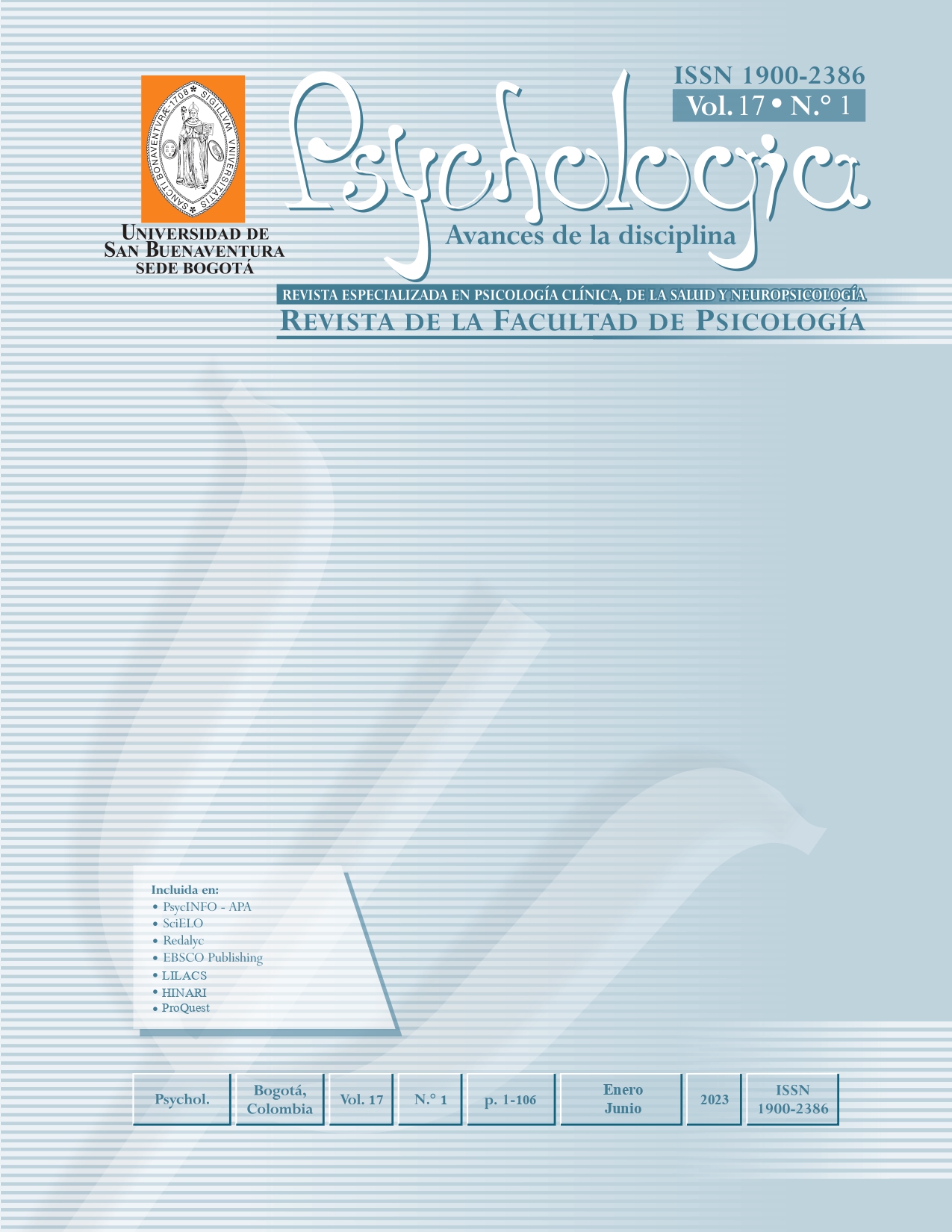This journal provides open, immediate access to its contents, based on the principle that offering the public free access to research helps to promote a higher global exchange of knowledge.
As such, all journal articles are published under a Creative Commons Attribution-NonCommercial-ShareAlike 4.0 International License (CC BY-NC-SA), by which commercial use of the original work or its possible derived works is not allowed, and the distribution thereof must be done with the same license elements regulating the original work.
http://creativecommons.org/licenses/by-nc-sa/4.0/
Abstract
The future perspective time is a cognitive motivational multidimensional process which influences the decisions of the teenagers about their future. This study pretended to analyze the relation between PTF and sociodemographic variables age, education level, gender and the city of residence, in a sample of 982 students, with ages between 12 and 18 years old, with a lower middle socioeconomic level, belonging to five schools in two cities in Colombia. Through an empirical analytical cross-sectional study, with correlational design, applied the questionnaire "Young people and the future" to measure the dimensions of attitude and temporal orientation and temporal extension. The results showed that 11th grade students, female gender, living in Acacías city, present the highest average in attitude and temporarily orientation dimensions. There were significant evidenced correlations between attitude, temporarily orientation, and temporal extensions dimensions with the sociodemographics variables studies. Which confirmes that the teenagers of both genders show interested in the future planning, which is higher based on level education and depends of the context were they live.
Keywords: Future time perspective, adolescence, Motivation, temporarily extension, temporarily orientation, sociodemographic variables.
References
Brenlla, M., Willis, B., & Germano, G. (2016). Estimación del tiempo y perspectiva temporal en distintas etapas de la adultez. Investigaciones en psicología, 21(1), 27-34. https://repositorio.uca.edu.ar/bitstream/123456789/6184/1/brenlla.pdf
Daura, F. (2017). Perspectiva temporal de los universitarios: implicaciones para la orientación educativa. Educación y Educadores, 20(3), 403-418. https://doi.org/10.5294/edu.2017.20.3.4
Del Río, A., & Herrera, A. (2006). Desarrollo de un instrumento para evaluar perspectiva del tiempo futuro en adolescentes. http://www.humanas.unal.edu.co/psicometria/files/7913/7036/4860/Desarrollo_De_Un_Instrumento_Para_Evaluar_Perspectiva_De_Tiempo_Futuro_En_Adolescentes.pd
Diaz, L., & Quintero, L. (2011). Evaluación de la perspectiva de tiempo futuro en adolescentes que culminan el bachillerato en la localidad Bogotana Usaquén (Trabajo de grado). Universidad de San Buenaventura. http://bibliotecadigital.usbcali.edu.co/bitstream/10819/729/1/Evaluaci%C3%B3n_perspectiva_tiempo_Diaz_2011.pdf
Ennis, N. E., Hobfoll, S. E., & Schroder, K. E. E. (2000). Money doesn’t talk, it swears: How economic stress and resistance resources impact inner-city
women’s depressive mood. American Journal of Community Psychology, 28, 149-173. https://doi.org//:10.1023/A:1005183100610
Ely, R., & Mercurio, A. (2011). Time perspective and autobiographical memory: Individual and gender differences in experiencing time and remembering the past. Time & Society, 20(3), 375-400. http://doi.org/10.1177/0961463X10366081.
Fernández, H., & Macbeth, G. (2018). Perspectiva de tiempo futuro, metas y sub-metas: su rol en la toma de decisiones. Revista Latinoamericana de Ciencia Psicológica, 10, https//doi.org/10.5872/psiencia/10.2.23
Ferrari, L., Nota, L., & Soresi, S. (2010). Time perspective and indecision in young and older adolescents. British Journal of Guidance & Counselling, 38(1), 61-82. http://doi.org/10.1080/03069880903408612.
Flórez, L., & Botero, H. (2020). Competencia Social y Salud Escolar: Un modelo de trabajo basado en el proceso motivacional humano. Manual Moderno. Editorial El Manual Moderno.
Fonseca-Pedrero, E., Paino, M., Lemos-Giráldez, S., & Muñiz, J. (2011). Prevalencia de la sintomatología emocional y comportamental en adolescentes españoles a través del Strengths and Difficulties Questionnaire (SDQ). Revista de Psicopatología y Psicología Clínica, 16(1), 15-25. https://doi.org/10.5944/rppc.vol.16.num.1.2011.10348.
Gargiulo, E. (2016). Metas vitales, perspectiva de tiempo futuro y vínculos positivos. un estudio comparativo en adultos jóvenes y adultos mayores de la ciudad de Mar del Plata (Trabajo de grado). Universidad Nacional de Mar del Plata. Repositorio RPsico. http://m.rpsico.mdp.edu.ar/bitstream/handle/123456789/456/0184.pdf?sequence=3&isAllowed=y
Gluck, M., Mercado, E., & Myers, C. (2009). Aprendizaje y memoria del cerebro al comportamiento. Mc Graw Hill.
Hammack, P. L., Robinson, W. L., Crawford, I., & Li, S. T. (2004). Poverty and depressed mood among urban African–American adolescents: A family stress
perspective. Journal of Child and Family Studies, 13, 309-323. QQ https://doi.org/10.1023/B:JCFS.0000022037.59369.90
Harris, K. M., Duncan, G. J. & Boisjoly, J. (2002). Evaluating the role of “nothing to lose” attitudes on risky behavior in adolescence. Social
Forces, 80(3), 1005-1039. https://doi.org/10.1353/sof.2002.0008
Herrera, D. (2019). Perspectiva de Tiempo Futuro y su relevancia motivacional en distintos contextos educativos. Propósitos y Representaciones. 7(SPE), e348. http://doi.org/10.20511/pyr2019.v7nSPE.348
Husman, J., & Lens, W. (1999). The Role of the Future in Student Motivation. Educational Psychologist, 34, 113-125. https://doi.org/10.1207/s15326985ep3402_4
Kilford, E., Garrett, E., & Blakemore, S. (2016). The Development of Social Cognition in Adolescence: An Integrated Perspective. Neuroscience and Biobehavioral Reviews, 70, 106-120. http://dx.doi.org/10.1016/j.neubiorev.2016.08.016
Kooij, D., Kanfer, R., Betts, M., & Rudolph, C. (2018). Future Time Perspective: A Systematic Review and Meta-Analysis. Journal of Applied Psychology, 103(8), 867-893. https://doi.org/10.1037/apl0000306
Lang, F., Weiss, D., Gerstorf, D., & Wagner, G. (2013). Forecasting life satisfaction across adulthood: Benefits of seeing a dark future? Psychology and Aging, 28(1), 249-261. https://doi.org/10.1037/a0030797
Lang, F. R., & Damm, F. (2018). Perceiving future time across adulthood. In G. Oettingen, A. T. Sevincer, & P. Gollwitzer (Eds.), The psychology of thinking about the future (pp. 310-331). The Guilford Press.
Lennings, C.J. (1994). An investigation of the effects of agency and time perspective variables on career maturity. The Journal of Psychology, 128(3), 243-253 https://doi.org/10.1080/00223980.1994.9712727
Lessing, E. E. (1968). Demographic, developmental and personality correlates of length of future time perspective. Journal of Personality, 36(2), 183-201. https://doi.org/10.1111/j.1467-6494.1968.tb01468.x
Lewin, K. (1951). Field theory in Social Sciences. Harpers.
Lewin, K. Z. (2001). Dynamic Psychology: Selected Works. Smysl.
Löckenhoff, C., & Carstensen, L. (2007). Aging, emotion, and health-related decision strategies: Motivational manipulations can reduce age differences. Psychol and Aging, 22(1), 134-146 https://:doi.org/10.1037/0882-7974.22.1.134
Lu, M., Li, A., Fung, H., Rothermund, K., & Lang, F. (2018). Different Future Time Perspectives Interplay in Predicting Life Satisfaction. GeroPsych, 31(3), 103-113. https://doi.org/10.1024/1662-9647/a000192.
Lukwago, A. N. D, Kreuter, M. W., Holt, C. L, Steger-May, K., Bucholtz, D. C., & Skinner, C. S. (2003). Sociocultural correlates of breast cancer knowledge and screening in urban African American women. American Journal of Public Health, 93, 1271-1274. https://doi,org/10.2105/ajph.93.8.1271
Mahon, N., Yarcheski, T. & Yarcheski, A. (2000). Future Time perspective and positive health practices among young adolescents: A further extension. Perceptual and Motor Skills, 90(1), 166-168. https://doi.org/10.2466/pms.2000.90.1.166
Martinez, P., & Estaun, S. (2004). Perspectiva temporal futura y satisfacción con la vida a lo largo del ciclo vital (Tesis Doctoral). Universitat Autónoma De Barcelona.
McCabe, K., & Barnett, D. (2000). First comes work, then comes marriage: Future orientation among African American young adolescents. Family relations, 49, 63-70. https://doi.org/10.1111/j.1741-3729.2000.00063.x
Mukhina, V. S. (1999). Developmental Psychology: phenomenology of development, childhood, adolescence: textbook. Academia.
Nuttin, J. (1985). Future time perspective and Motivation. Leuven University Press & Lawrence Erlbaum Associates
Nuttin, J. M. (2004). Motivation, Action and Future Time Perspective. Smysl.
Padawer, A., Jacobs, M., Hershey, A., & Thomas, G. (2007). Demographic indicators as predictors of future time perspective. Current Psychology, 26, 102-108. http://doi.org/10.1007/s12144- 007-9008-4
Peetsma, T. T. D. (2000). Future Time Perspective as a Predictor of School Investment. Scandinavian Journal of Educational Research, 44(2), 177-192. https://doi.org/10.1080/713696667
Peterson, G., Sampson, J., Lenz, J., & Reardon, R. (2002). Becoming career problem solvers and decision makers: A cognitive information processing approach. In D. Brown (Ed.), Career choice and development (pp. 312-369) (4 ed.). Jossey-Bass.
Prenda, K., & Lachman, M. (2001). Planning for the future: A life management strategy for increasing control and life satisfaction in adulthood. Psychology and Aging, 16(2), 206-216. https://doi.org/10.1037/0882-7974.16.2.206
Quiñonez, Y. (2015) Análisis pre-experimental de la efectividad de los talleres incluidos en el componente “de cara a la vida” del programa arcos, y evaluación de las asociaciones entre sus resultados y el rendimiento académico en estudiantes de grado décimo del colegio distrital Cristóbal Colon de Bogotá (Trabajo de grado). Universidad de San Buenaventura, Bogotá. http://biblioteca.usbbog.edu.co:8080/Biblioteca/BDigital/138685.pdf
Seginer, R., & Lens, W. (2015). Future orientation: different approaches, different cultures. En M. Stolarski, N. Fieulaine & W. VanBeek (Eds.), Time Perspective Theory; review, research and application: Essays in honor of Philip G. Zimbardo. Springer.
Sundaramurthy, S., Bush, T. M., Neuwelt, C. M., & Ward, M. M. (2003). Time perspective predicts the progression of permanent organ damage in patients with systemic lupus erythematosus. Lupus, 12(6), 443-448. https://doi.org/10.1191/0961203303lu410oa
Teuscher, U., & Mitchell, H. (2011). Relation between time perspective and delay discounting: A literature review. The Psychological Record, 61, 613-632. http://dx.doi.org/10.1007/BF03395780
Trommsdorff, G. (1983). Future orientation and socialization. Journal of International Psychology, 18(1-4), 381-406. https://doi.org/10.1080/00207598308247489
Wadsworth, M. E., & Santiago, C. D. (2008). Risk and resiliency processes in ethnically diverse families in poverty. Journal of Family Psychology, 22(3), 399-410. https://doi.org/10.1037/0893-3200.22.3.399
Zaleski, Z., Cycon, A., & Kurc, A. (2001). Future time perspective and subjective well-being in adolescent samples. En: P. Schmuck & K. M. Sheldon (Eds.), Life goals and well-being: Towards a positive psychology of human striving. Hogrefe & Huber Publishers.

 Perfil Google Scholar
Perfil Google Scholar




















